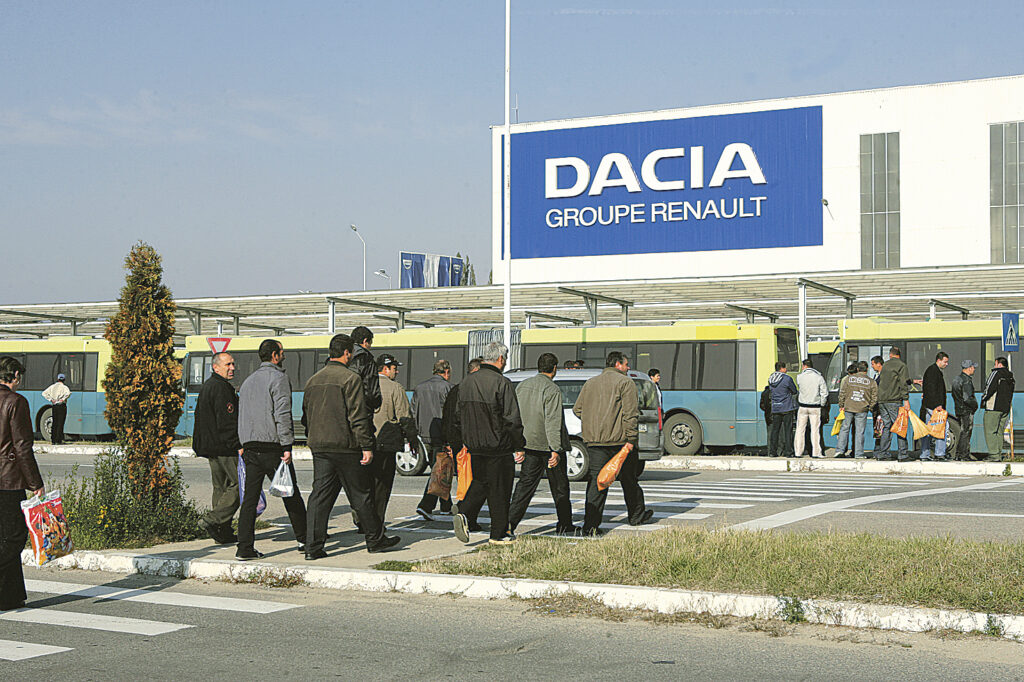What would the Romanian economy look like without Dacia? Many tried to picture this during the last spring, when the French investors implied that lack of modern and rapid transport infrastructure, but also the fiscal and legislative unpredictability might force them to consider relocating the Mioveni factory. And the resulting image wasn’t at all pleasant. That’s because the vehicle manufacturer is directly responsible for about 3% of Romania’s GDP and for about 8% of country’s exports. Dacia directly employs over 13,000 people, other 10,000 to 20,000 working for the company’s suppliers.
Now, after you have visualised Romania without Dacia, try picturing the Arges County’s economy without the famous brand. “It would be a pure disaster. It would become a second Jiu Valley”, according to the manager of a company whose revenues are highly dependent on the orders received from Mioveni. In case Dacia lives, the county’s economic indicators would significantly change indeed – the per capita GDP (which is currently 10% above the national average) would collapse, the average wage (which is 5% above the national average) would shrink, while the unemployment rate, already big enough (5.6% as compared to the national average of 5.1%) might double if not even worse. Let alone the exports (they currently reach five billion EUR per year, about four billion EUR being exclusively due to the French company).
Recent victims
But Dacia is nothing more than the tip of the iceberg. There are quite numerous towns, counties and even regions in Romania that are depending too much on a company or on an economic sector. And which are either at risk of collapsing together with the said company or industry or are trapped in a vicious circle and don’t succeed to forget a “recipe” which keeps them away from the development trends.
One of the cases is the Beius-Stei area in Bihor County, where several towns just few kilometres away host the food and beverages factories owned by the famous Micula brothers. The investments they made in the area were for years a blessing for an underdeveloped region in the Apuseni Mountains, but there is also the other side of the shield. As their business didn’t perform in the past years as well as in the ‘90s or in the early 2000s, the two entrepreneurs laid off some of their personnel, which had arrived to 11,000 people at some point. With a few exceptions, the fresh unemployed people haven’t found any job in the area.
A little bit further to the East, in Campia Turzii, over 2,000 workers lost their jobs since 2012, when the steel factory belonging to the Russian company Mechel started having problems. The company is the biggest in the 22,000-inhabitant town and, even if the more populated Turda and Cluj Napoca are not that far away, the individuals who were laid off had a hard time finding other jobs.
With a few exceptions, entire counties from the Baragan region (Teleorman, Giurgiu, Calarasi or Ialomita) keep on having an economy based on the same sector which employed tens of generations of ancestors: the agriculture (and the related activities, such as the food industry). Beyond the small salaries and the mostly unskilled jobs, the biggest problem is that Romanian crops are still highly dependent on the weather, so tens of thousands of jobs are at stake in case of drought or heavy rains. The case of these regions is even stranger as they are within a stone’s throw from Bucharest and are connected to the capital city by modern infrastructure (motorways or upgraded highways, upgraded railways). More, they are bordered for hundreds of kilometres by the Danube. Despite all these, they seem unable to fructify the advantages.
Historical explanations
All the above mentioned cases have, to a greater or lesser extent, the potential to replicate the negative effects the monotown phenomenon already had in various places around the country. The Jiu valley is probably the best example, and the way the region doesn’t succeed to find a new road and identity almost 20 years after the mines began to close says a lot about the risks.
The unprofitable mines that were closed also radically changed the life of some communities in Banat (like Anina) or in Transylvania (such as Balan). “In Balan, for example, the coal mine was the sole industry, so that over 83% of the active population worked there or in places indirectly connected to the mine. Closing the mine had a catastrophic impact, the number of jobs dropping by almost 90% and almost half of the inhabitants left the town”, pointed out a report issued by the Romanian Academic Society (SAR). But similar stories, marked by long term unemployment, temporary or underpaid jobs, numerous people going back to the subsistence agriculture or a large scale migration also took place in towns like Victoria (dependent on the chemical industry) or Plopeni (dependent on the mechanical engineering).
The forced industrialization during the communist regime is mostly responsible for these cases. In 1930, only one town in Romania, Resita, had over 50% of the active population employed in a sole industrial sector, other three being in the area of the relative dependency (30% to 50%), according to a study issued by dr. Dana Bianca Dumitrescu.
Few decades later, there were ten monotowns in the extractive industry alone (in Uricani, for example, over 70% of the labour force was employed by the coal mine), two in metallurgy, six in the mechanical engineering (with Plopeni and Cugir having over 65% of the employees in this sector), one in the chemical industry (Victoria) and two in the light industry. There were joined by 12 other towns with between 30% and 50% of the employees active in the same sector.
10% of the Arges County employees, i.e. over 13,000 people, are directly depending on Dacia. It is estimated that the factory’s local suppliers employ a similar number of people
Beyond the borders
RUSSIA There are about 900 monotowns. A sixth of country’s population lives in such places. Meanwhile, the monotown companies are responsible for about 30% of the GDP.
GERMANY The famous Ruhr Valley has nowadays about 8.5 million inhabitants. Most of them are the descendants of the emigrants that flooded the region in the past 150 years, for working in mines and steel factories. After the natural resources exhausted, the region went through an economic crisis, but managed to diversify its economy and to become again one of Germany’s engines.
USA The high level of mobility in the population made monotowns experiencing economic problems to be rapidly abandoned by their inhabitants. Nevertheless, not everybody leaves and those remaining are usually confronting a significant deterioration of living conditions. For example, Detroit had 1.85 million inhabitants in 1950 and arrived to 0.7 million in 2013, after the car industry’s decline. The unemployment rate reached 23% and over a third of the locals are below the poverty line.







